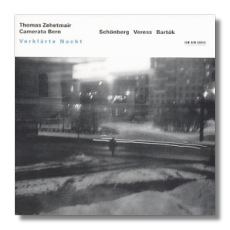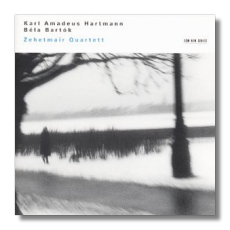
The Internet's Premier Classical Music Source
Related Links
-
Bartók Reviews
Hartmann Reviews
Schoenberg Reviews
Veress Reviews - Latest Reviews
- More Reviews
-
By Composer
-
Collections
DVD & Blu-ray
Books
Concert Reviews
Articles/Interviews
Software
Audio
Search Amazon
Recommended Links
Site News
 CD Review
CD Review
ECM New Series

- Arnold Schoenberg: Transfigured Night
- Sándor Veress: Four Transylvanian Dances
- Béla Bartók: Divertimento
Thomas Zehetmair, violin
Camerata Bern/Thomas Zehetmair
ECM New Series 1714 465778-2 DDD 64:48


- Karl Amadeus Hartmann: String Quartet #1 "Carillon"
- Béla Bartók: String Quartet #4
Zehetmair Quartet
(Thomas Zehetmair, Ulf Schneider; violins
Ruth Killius, viola; Françoise Groben, cello)
ECM New Series 1727 465776-2 DDD 43:01
These two CDs have the Salzburg-born violinist Thomas Zehetmair in common. Zehetmair, already having established a solo career for himself, formed an eponymous string quartet in 1997. As one of the concertmasters of Camerata Bern, he also takes turns directing that ensemble, and he has expanded his interest in conducting through appearances with the Scottish Chamber Orchestra and with other ensembles.
These two CDs make a complementary pair. On the first CD, Camerata Bern does its best to restore the ability of Transfigured Night to stop the listener short. This rather Mengelberg-like reading contains impetuous tempo-changes – one section of the score collides against another – and expressionistic string playing. Camerata Bern jealously hoards its vibrato, and the tone is more characteristic of gut strings than modern-day equivalents. The result is a Transfigured Night that is less erotic and more agitated than most. It is an interesting reading to be sure.
Sándor Veress' Four Transylvanian Dances out-Bartók Bartók. The younger Hungarian composer completed these dances in the late 1940s shortly after he had decided not to return to his homeland and risk political and artistic repression and it is hard not to hear both defiance and a leave-taking in this music. The composer describes the dances as "free re-creations of certain styles of dance music indigenous to Hungarian villages, particularly to the Székler of Transylvania." (This is ironic, because Transylvania is no longer part of Hungary.) In other words, these are not "folk-tune settings," although one could be forgiven for thinking otherwise, given the plainspoken roughness and angularity of Veress' music.
Bartók was Veress' mentor, and he preceded his student into exile by about a decade. The Divertimento, like the Four Transylvanian Dances, was written around the time of the composer's actual emigration. Another similarity is the music's blending of proud nationalism with, in the second movement, regret over his country's political situation. Where Bartók departs from Veress, however, is in the Divertimento's classical concern for form and proportion. It is one of the works that initiated Bartók's "late period." Compared to Pierre Boulez and the Chicago Symphony Orchestra (Deutsche Grammophon 445825-2), Zehetmair and Camerata Bern are appealingly athletic, with faster tempos and a more sinewy tone. Boulez, on the other hand, makes more of the concerto grosso elements in the score. All in all, this is a solid, interesting program from the Swiss ensemble.
The quartet CD, short as it is, is an even more stimulating proposition. Again, the program's theme is Bartók and the composers who love him. In this case, the admiring party is Karl Amadeus Hartmann (1905-1963), a composer whose work is admired on the European mainland, although he hasn't caught on in other places. His First String Quartet (subtitled "Carillon," for the chamber music society in Geneva that awarded it a prize) was written in 1933, five years after Bartók completed his Fourth Quartet. There are similarities. Both works explore arch-form, within movements and through the course of the works as a whole. Both have second movements marked con sordino (to be played with mutes). Both contrast emotion with method. Hartmann's First Quartet is an astonishingly assured work for such a young man. The density of the writing makes it hard to believe, at times, that only four instruments are playing. The first movement starts with a lamenting introduction, and then explodes into the lacerating main section in which the interval of a semitone is prominent – another echo of Bartók's Fourth Quartet. The lyrically ghostly middle movement is so exquisitely crafted that it makes one hold one's breath. The finale, like the corresponding movement in Bartók's quartet, is fast and furious, but Hartmann is even more careful to add contrasting passages. In the end, the ear is always interested by this quartet, even though its materials are often tough, even aggressive.
The Bartók Fourth Quartet is one of the set's most familiar, perhaps because of its mirror-like construction. The fabulous "night music" of the middle movement is surrounded by the second and fourth movements (studies in spidery con sordino and pizzicato playing, respectively – it is here that the explosive "Bartók pizzicato" was created) and the bookends of the confrontational first and brutal fifth movements.
The members of the Zehetmair Quartet are fearless in these two works. The musical dangers are met head-on in performances that slash and burn. However, in the middle movements of each quartet, the musicians reveal their finesse, and their comfort with the shadowy worlds that the music inhabits. In the Bartók's second movement, other quartets have emphasized rhythm more; the Zehetmairs seem most fascinated by the weird, abstract sonorities that Bartók asks for. They make it work.
The engineering is excellent on both CDs, particularly on the quartet disc. Also, the booklet notes for this second disc are superbly detailed – a nice change from the obscurantism that ECM New Series releases fall prey to at times.
Copyright © 2001, Raymond Tuttle




















